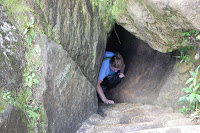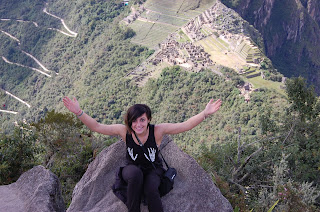Located in the Andes Mountains in Peru rests Machu Picchu, a 15th century Inca citadel and one of the most important archaeological sites in the world. Machu Picchu is 2,430 meters ( approximately 7,970 feet) above sea level in the Cusco Region of Peru. The location of Machu Picchu is astounding, as it rests on the side of a steep ridge overlooking the turbulent Urubamba River, but that is what makes it so fascinating. (Specifics on Machu Picchu to be continued in the next blog post!)
Towering just behind the site of Machu Picchu is Mount Huayna Picchu (otherwise known as Wayna Picchu, which is the Hispanic spelling). The Urubamba River bends just around this mountain that towers 360 meters (~1,180 feet) above the site of Machu Picchu, and it 2,720 meters (~8,920 feet) above sea level. The Incas built a path to the top of the mountain, in which it is believed that smalls groups of people would journey every morning to signal the start of a new day. This path can be taken by travelers and tourists coming onto the site, but there is no way around hiking to the top. Yes, that's right, everyone has to hike the same path the Incas took!
The path, in some areas, has a thick wire to hold onto, but other than that, it is free reign. Anyone taking this trail will be hiking on uneven ground, jagged rocks, and up incredibly steep sections. Personally, I find that this makes the adventure far more enjoyable because of the experience it allows. There are regulations to taking this trail, though. Only 400 people are allowed to hike Huayna Picchu a day, and it gets separated into two groups (this is done in order to preserve the mountain and ruins). The hike itself takes about 1.5-2 hours up for the average person, and about .75-1 hour back down. Make sure you bring lots of water, and even a few granola bars or a sandwich just in case!
The view from the entire hike is astounding. As you climb the steep slopes, the view of Machu Picchu below becomes better and better. It looks as though the mountain peaks in the surrounding area are reaching up and touching the clouds. You can also see the zig-zagged bus path that leads up the side of the mountain and the rushing Urubamba River below.
Picchu and there are even temples on the steep mountain. Around the terraces, there are small steps to walk up and you can go out onto the terraces and overlook the valleys below. It's amazing to think about how they managed to built these creations in precarious areas. It's even more amazing that they are so well preserved that some of us get the chance to see them firsthand and get this once-in-a-lifetime experience.
Keep on going up and the peak starts to come into view. There is a small, narrow cave everyone has to crawl through one at a time and at the end is a makeshift wooden ladder, held together by frayed rope. Climb up that and--Voila! You are at the peak of Huayna Picchu!
This is nothing like a peak most tourists would expect. It's not made to have a platform or railings, it is literally the tip of the mountain, jagged rocks and all. The air is fresh and the echoes of the river below are relaxing--unless heights make you nervous! A few people up there--myself and my aunt included--crawled out to sit backwards on the edge of one of the rocks. It is a feeling like no other. The mix of relaxation and adrenaline is a unique feeling, literally taking your breath away.
Once done at the top, the trek down begins. Sure, the time is shorter, but the way down is far more precarious. How? Well, you'll be first stepping down to the
very narrow path (approximately 1-1.5 feet in width) and have to shimmy along it until you reach this giant stone that gives you maybe 8 inches of the path to work with. Don't look down--there's a sheer drop right behind you. After you're around that, you climb down the stairs that run alongside the terraces. If you think that sounds easy, wait until you do it! The stairs are extremely narrow (one foot can fit the length of one) and very uneven. The terraces offer some support, if you can find areas of the rocks to squeeze your hands through. That sheer drop is still right behind you and you can hear the wind howling in your ears as you make your journey to the bottom.
When you make it past the narrow pathway and the terraces, the rest of the hike is not so bad. You'll have to
jump down the rocks or climb at certain areas, but it's nothing like the hike up. If you are in the second group, make sure you check your times and make it back down to the bottom before the early afternoon rains start! They set up the two hiking trips in the morning so no one gets caught up on the mountain while it's raining because of how dangerous it is. (Be careful on this hike anyway because they do not land helicopters on the mountain and the only other way to retrieve someone that has been injured is to have medics hike up the mountain to your location.)
(My aunt booked our trip through Abercrombie & Kent Travel Agency; all photos taken by me on a Nikon D40 (except for the one of me at the peak, which was taken by our wonderful tour guide, Edgar.))











No comments:
Post a Comment